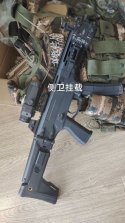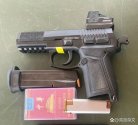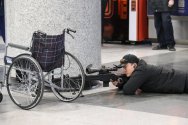Might just be PLA photographers don't serve military roles before being offered the job, so they only consider what looks "Cool" rather than whats practical. I think it's only photography that really suffers from this, the PLA related video content is generally pretty good.Just second-hand embarrassment, and it is just a problem that can be easily fixed but no one seems to want to fix it which annoys me. No biggie, just a personal issue.
You are using an out of date browser. It may not display this or other websites correctly.
You should upgrade or use an alternative browser.
You should upgrade or use an alternative browser.
PLA Small arms
- Thread starter Vanguard1688
- Start date
Then they need to find a better opening instead of worrying about compensating for the cant. Sure, in a pinch, that might work for shorter ranges if you're an infantryman. If you're a sniper, you'd be better off finding a different location altogether.
I'm not an expert but is it that hard to compensate for it? The markings in the scope help you estimate target distance and bullet drop, one just need to mentally transpose it 90 degrees to make it work. Yeah it's not perfect and probably not as accurate but doable in a pinch I guess
by78
General
I'm not an expert but is it that hard to compensate for it? The markings in the scope help you estimate target distance and bullet drop, one just need to mentally transpose it 90 degrees to make it work. Yeah it's not perfect and probably not as accurate but doable in a pinch I guess
In a pinch, you can do it if you're an infantryman engaging a target at 100, 200 yards, provided that you already know how much to compensate at those distances. At sniping distances (e.g. 600 yards) it becomes another matter, because the further you try to reach, the less likely you will be able to compensate effectively. Also keep in mind, the markings in the scope also take into consideration the scope's height off bore, which becomes zero when you cant your rifle 90 degrees, so there goes your ballistic table out the window.
In a pinch, you can do it if you're an infantryman engaging a target at 100, 200 yards, provided that you already know how much to compensate at those distances. At sniping distances (e.g. 600 yards) it becomes another matter, because the further you try to reach, the less likely you will be able to compensate effectively. Also keep in mind, the markings in the scope also take into consideration the scope's height off bore, which becomes zero when you cant your rifle 90 degrees, so there goes your ballistic table out the window.
You're right. It just occurred to me the axis of aim is not guaranteed to be parallel to the barrel
plawolf
Lieutenant General
In a pinch, you can do it if you're an infantryman engaging a target at 100, 200 yards, provided that you already know how much to compensate at those distances. At sniping distances (e.g. 600 yards) it becomes another matter, because the further you try to reach, the less likely you will be able to compensate effectively. Also keep in mind, the markings in the scope also take into consideration the scope's height off bore, which becomes zero when you cant your rifle 90 degrees, so there goes your ballistic table out the window.
There are no markings on a rifle scope for height over bore (HoB). You have zeros set to your HoB, range, wind, elevation and ammo etc.
Many modern combat scopes also have Christmas tree grids for more reference points, which might actually work pretty well canted.
Of course the point of impact and range drops will all but different, but that’s all reasons why it’s useful to train for this so you have a second ballistic table to use, and know exactly what the drops and compensations are.
I think all this canted aiming might have started off as a bit of a novelty trick-shot, but it’s hard not to think it’s relevant when looking at footage from Gaza.
How many videos have we seen where soldiers expanding a hole in a wall to allow them to better aim out of have resulted in their position getting compromised and the whole building spammed with RPGs/missiles/tank rounds?
In urban combat, engagement ranges are not going to be massive. What is far more important is concealment and surprise. Being able to effectively shot from a gap the other side would immediately write off as too narrow will massively improve your survival chances as well as offer you a lot more useable vantage points.
D
Deleted member 13257
Guest
This is a training gun model



